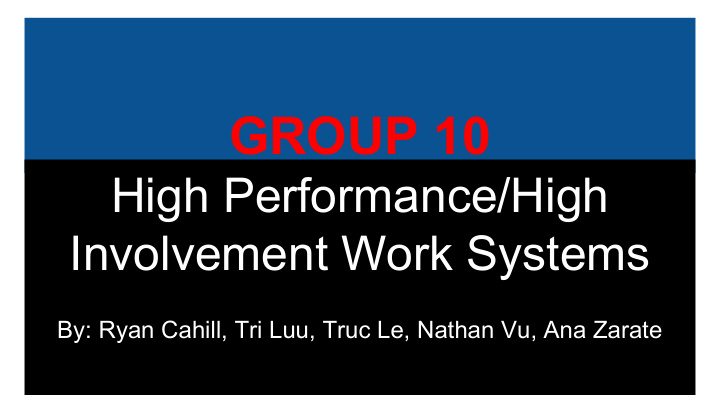



GROUP 10 High Performance/High Involvement Work Systems By: Ryan Cahill, Tri Luu, Truc Le, Nathan Vu, Ana Zarate
Presenter: Ryan Cahill High Performance Work Systems and Teachers’ Work Performance: The Mediating Role of Quality Work Life
Focus What are the core attributes about a HPWS’s that actually make them successful? What key factors in HPWS’s that actually contribute to employee attitudes, behaviors and ultimately better performance?
Key Terms - High Performance Work Systems - High Involvement Work Systems - Quality of Working Life
Methods and Measures ● Guangdong Province ● HPWS’s ● QWL ● Mediating Effect “This Parent Organizes activities with Parents”
HPWS’s have no shortcut to achieving Extra Role Behavior
Take Home Message ● Clearly Identify what OCB’s are. Measure them. QWL must also be measured. ● Difference between Big business & Small business HPWS’s training on what are the key areas that bring QWL. ● OCB’s if they are consistently expected, they should eventually become a part of the job description. OCB’s
Presenter: Truc Le High Performance Work Systems, Joint Impact of Transformational Leadership, an Empowerment Climate and Organizational Ambidexterity By: Ryan Cahill
Key Terms - Empowerment Climate - Organizational Ambidexterity - Transformational Leadership
Focus - Impact of the High-performance work system to Organizational Ambidexterity - The intervention of Empowerment Climate
Take-home Messages - Conduct training programs - Acquire new and challenging skills
Presenter: Nathan Vu The Role of Employee HR Attributions and the Relationship between High-Performance Work Systems and Employee Outcomes
Focus ● Confirm the relationship between HR well-being practices and HR performance practices and how they associate with employee commitment and levels of job strain
Methods and Measures ● Study: Survey for line managers and employees (1065 employees) ● Measurements: ○ Based off of 5 core HPWS activities to promote well-being and to get the most work out of employees ○ Hiring, Performance, Rewards, Development, and Communication Ranked survey questions for each aspect being measured Wide variety of industries in profit and nonprofit sectors
Results ● Positive correlation between HR well-being and commitment while negative to job strain ● HR performance was only positively correlated with job strain No significant relationship between HR performance attributions and organizational commitment
Take-home Message ● Communicate that organizations care about the well-being and development of their employees (more social resources and support on the job) ● Increase coverage of work for employees ● Stress management and health promotion programs to minimize job strain
Presenter: Ana Zarate How HIWPs create environmentally based sustainable competitive advantages
Focus Does high-involvement work practices enhance a firm’s economic performance through the development of a proactive environmental strategy.
Key Terms -Proactive Environmental Strategy(PES): -High-Involvement Work Practices (HIWPs)
Methods Sample: 233 firms (10 or more employees) Surveyed by mail CEOs/presidents were addressed
Measures Firm Performance: Four-item scale: Economic Profit, Return on Total assets, Profit per employee, profit margin PES: Rate 1-7, 1=have not addressed this factor & no plan to 7=we are the leaders on this in our sector HIWP: % of employees receiving incentives per perf appraisals
Results
Take-Home Message Develop a strategic capability like a PES that will be the mediating role to a firm’s performance. - Conducting environmental quality audits regularly - Performing natural environmental training for firm employees
Presenter: Tri Luu The link between perceived HRM practices, performance and well-being: The moderating effect of trust in the employer.
Focus Trust in the employer moderates the relationship between HRM Practices and Task Performance
Key Terms ● What is “HPWS”? ● What is “Trust”? ● What are some “HRM practices”? ● What is a “Task Performance”?
Methods and Measures ● Perceived HRM practices (9) - ○ Internal reliability of � = 0.91 ● Trust in the employer (7) - ○ Internal reliability of � = 0.97 ● Task performance - ○ Scale from 1 (‘very poor’) to 5 (‘very good’).
Trust in the employer moderates the relationship between HRM practices and task performance
Take-home Messages Trust is a two-way street for HPWS to work. Employees needs to trust the autonomy workspace. ● Ex. Give employee flexibility (not micromanagement) to be creativity relates to OCB. ● Ex. 360 Feedback
Group Take-home Message Efficient HPWS encompass: ● Trust ● Communication ● Empowerment ● Training ● Quality of working life Key factor: Value employees to produce positive results in a high performance work system Employer interests are only met if employee interests are met first
Recommend
More recommend